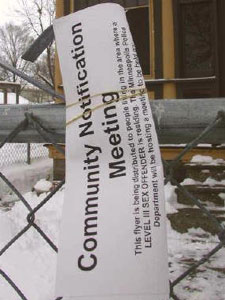|
Audio
Photos
More from MPR
Your Voice
|
Minneapolis neighborhoods home to clusters of released sex offenders
February 5, 2004
 |
| About every two months residents of the Phillips neighborhood are notified of a Level III sex offender moving in (MPR Photo/Art Hughes) |
Minneapolis, Minn. — Since the 1997 Sex Offender Notification law required publicizing a repeat offender's release from prison, offenders seeking cheap apartments and relative anonymity have turned to poorer, urban settings. In Minnesota, they have concentrated in two Minneapolis neighborhoods: Phillips and Jordan.
After getting sex offender meeting notices every eight weeks, long-time Phillips resident Paul Weir became active trying to thwart the trend--with little success.
 | |||
"There's no evil genius out there directing Level III sex offenders to Phillips or to Jordan or to wherever... at least in my view they're not", Weir said. "What's happening here is that for various really complicated socioeconomic reasons Phillips is a natural place for these people to light. And they do."
At any given time, Phillips and Jordan each house up to 17 Level III sex offenders. Other neighborhoods may have from one to three. Most neighborhoods have none. Level III sex offenders are those considered most likely to re offend. Craig Vos, who manages adult probation for Hennepin County, said it comes down to where repeat offenders can find a home.
"There are a small number of landlords who are willing to rent," Vos said. "They tend to own property in the two neighborhoods. Often they will own two or three buildings near each other."
Residents in the urban areas are more often poor with less education, many times they're immigrants with limited English. So the public outcry can be muted compared to more affluent neighborhoods.
 | |||
Minneapolis Police Offender Notification Supervisor Jon Hinchliff said there's little evidence clustering of sex offenders causes an increase in violent sex crimes. But he said the stigma brings property values down and makes neighbors feel defeated.
"It goes to livability issues in those neighborhoods," Hinchliff said. "The perception that nobody cares, that our neighborhood is a dumping ground, that what's the use, how can we turn this around it's impossible..."
Hinchliff thinks one alternative is to funnel offenders to a designated site outside of residential areas.
"Maybe a location off of the loop downtown in more of a working or industrial area where a certain percentage could be housed," he said.
 | |||
Every year, the city's legislators try new ideas to break up the concentrations, but have had little success.
Rep. Joe Mullery, DFL-Minneapolis, proposes requiring offenders to live 500 feet from one another has little backing outside of Minneapolis. He did get language passed that asks officials to try and disperse offenders, but he said that still rarely happens.
"What I'm told is that the probation officers are so inundated from their work because of cutbacks in money from the state that they just don't have time to thoroughly investigate the possibilities for other housing." Mullery said.
To make matters worse the county now faces a new money crunch.
The sudden scrutiny of offender monitoring after the arrest of suspect Alfonso Rodriguez Jr., in the disappearance of Dru Sjodin prompted the State Department of Corrections to refer all freed sex offenders to county attorneys to determine if an offender warrants commitment to a mental institution. In the past two months Hennepin County has gotten more than 100 such referrals. The same time last year the county had just three.
County Commissioner Peter McLaughlin said if Hennepin is to be the destination for offenders from all over, the state should help pay for the costly assessment and monitoring.
"The financial burden that Hennepin County taxpayers are being asked to bear as the state retreats and the sex offenders are heavily concentrated---disproportionately concentrated in Hennepin County--that's not acceptable," McLaughlin said. "It's not fair to either our taxpayers or to the communities where these individuals are residing."
The clustering problem could get worse before it gets better. Officials are calling for longer sentences and closer monitoring. But new sentences wouldn't apply to offenders now waiting release from prison.
|
News Headlines
|
Related Subjects
|
